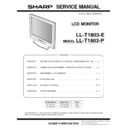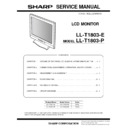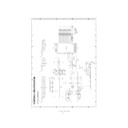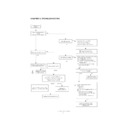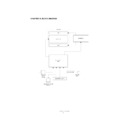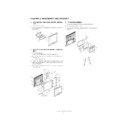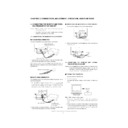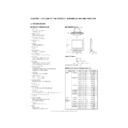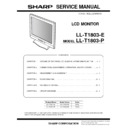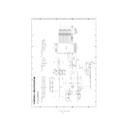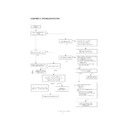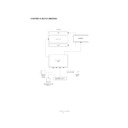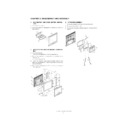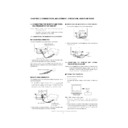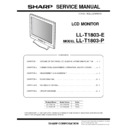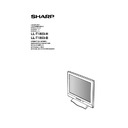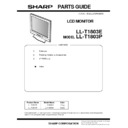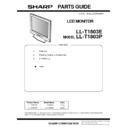Sharp LL-T1803 (serv.man8) Service Manual ▷ View online
LL-T1803-E/P
OUTLINE OF THE PRODUCT, NOMENCLATURE AND FUNCTION
1 – 2
• Recommended resolution is 1280
u
1024.
• All are compliant only with non-interlaced.
• Frequencies for Power Macintosh and the Sun Ultra series are refer-
ence values. To connect, another adapter (purchased separately)
may be required.
may be required.
• If the monitor is receiving timing signals that are not compatible, [OUT
OF TIMING] will appear.
Follow your computerÅfs instruction manual to set the timing so that it
is compatible with the monitor.
is compatible with the monitor.
• If the monitor is not receiving any signal (synch signal), [NO SIGNAL]
will appear.
■
■
■
■
RELEVANT SIGNAL TIMINGS (DIGITAL)
• Recommended resolution is 1280
u
1024.
• All are compliant only with non-interlaced.
• A computer with an output terminal conforming to DVI (DVI-D24 pin
or DVI-I29 pin) and with SXGA output capability can be connected
here.
(Depending on the type of computer to be connected, the display may
(Depending on the type of computer to be connected, the display may
not work correctly.)
• If the monitor is receiving timing signals that are not compatible, [OUT
OF TIMING] will appear.
Follow your computer's instruction manual to set the timing so that it
Follow your computer's instruction manual to set the timing so that it
is compatible with the monitor.
• If the monitor is not receiving any signal (synch signal), [NO SIGNAL]
will appear.
■
■
■
■
THE ANALOG SIGNAL INPUT CONNECTOR PIN
■
■
■
■
THE DVI-D INPUT CONNECTOR PIN
■
■
■
■
POWER MANAGEMENT
The monitor is based on the VESA DPMS*1 and the DVI DMPM*2 stan-
dards.
To activate the monitor's Power Management function, both the video
card and the computer must conform to the VESA DPMS standard and
card and the computer must conform to the VESA DPMS standard and
the DVI DMPM standard.
* 1 DPMS: Display Power Management Signalling
Sun Ultra
series
series
1024
u
768
48.3kHz
60Hz
64.13MHz
53.6kHz
66Hz
70.4MHz
56.6kHz
70Hz
74.25MHz
1152
u
900
61.8kHz
66Hz
94.88MHz
71.8kHz
76.2Hz
108.23MHz
1280
u
1024
71.7kHz
67.2Hz
117.01MHz
81.1kHz
76Hz
134.99MHz
Display mode
Hsync
Vsync
Dot frequency
VESA
640
u
480
31.5kHz
60Hz
25.175MHz
37.9kHz
72Hz
31.5MHz
37.5kHz
75Hz
31.5MHz
800
u
600
37.9kHz
60Hz
40.0MHz
48.1kHz
72Hz
50.0MHz
46.9kHz
75Hz
49.5MHz
1024
u
768
48.4kHz
60Hz
65.0MHz
56.5kHz
70Hz
75.0MHz
60.0kHz
75Hz
78.75MHz
1152
u
864
67.5kHz
75Hz
108.0MHz
1280
u
960
60.0kHz
60Hz
108.0MHz
1280
u
1024
64.0kHz
60Hz
108.0MHz
US text
720
u
400
31.5kHz
70Hz
28.3MHz
Display mode
Hsync
Vsync
Dot frequency
DPMS mode
Screen
Power
consumption
H-sync
V-sync
ON
Display on
49W
Yes
Yes
STANDBY
Display off
3.5W
No
Yes
SUSPEND
Yes
No
OFF
No
No
5
1
2
3
4
10
6
7
8
9
15
11
12
13
14
(Mini D-sub connector with 15 pins)
Number
Function
1
Red video signal input
2
Green video signal input
3
Blue video signal input
4
GND
5
GND
6
For red video signal GND
7
For green video signal GND
8
For blue video signal GND
9
DDC+5V
10
N.C.
11
GND
12
DDC data
13
For Hsync signal input
14
For Vsync signal input
15
DDC clock
1
7
6
5
4
3
2
8
9
15
14
13
12
11
10
16
17
23
22
21
20
19
18
24
(DVI-D connector with 24 pins)
No. Function
No. Function
1
TMDS data 2-
13 N.C.
2
TMDS data 2+
14 +5V
3
TMDS data 2/4 shield 15 GND
4
N.C.
16 Hot plug detection
5
N.C.
17 TMDS data 0-
6
DDC clock
18 TMDS data 0+
7
DDC data
19 TMDS data 0/5 shield
8
N.C.
20 N.C.
9
TMDS data 1-
21 N.C.
10 TMDS data 1+
22 TMDS clock shield
11 TMDS data 1/3 shield 23 TMDS clock +
12 N.C.
12 N.C.
24 TMDS clock -
LL-T1803-E/P
OUTLINE OF THE PRODUCT, NOMENCLATURE AND FUNCTION
1 – 3
■
■
■
■
DDC (PLUG & PLAY)
This monitor supports the VESA DDC (Display Data Channel) standard.
DDC is a signal standard for carrying out Plug & Play functions on the
monitor or PC. It transfers information such as degree of resolution
between the monitor and PC. You can use this function if your PC is
between the monitor and PC. You can use this function if your PC is
DDC compliant and if it is set so that it can detect the Plug & Play mon-
itor.
There are many varieties of DDC due to the differences between sys-
There are many varieties of DDC due to the differences between sys-
tems. This monitor works with DDC1 and DDC2B.
2. PRODUCT DESCRIPTION
■
■
■
■
STANDING UP AND ADJUSTING THE MONITOR
Caution: • Pressure from hands on the LCD panel could cause damage.
• Be careful not to allow your fingers to be pinched.
Standing up the monitor
Press down on the stand and lift up the top section of the monitor.
Folding up the monitor
1. Remove the AC adapter and the RGB signal cable.
2. If carrying out adjustments to the monitor, place it upright.
3. While pressing the rear lock disable button (1), gently fold back the
monitor (2).
Angle adjustment
Adjust to an easy to view angle.
1.
INPUT button
To switch between the signal’s input terminals.
(Analog signal input terminal
(Analog signal input terminal
0
DVI-D input ter-
minal)
2.
MENU button
This button is used to pop-up, select and close
the OSD (On Screen Display) Menu.
the OSD (On Screen Display) Menu.
3.
SELECT button This button is used to select menu options when
the OSD Menu is displayed.
4.
e d
buttons
When the OSD Menu is displayed:
These buttons are used to increase or decrease
the value of a selected option.
When the OSD Menu is not displayed:
These buttons are used to adjust backlight
brightness.
These buttons are used to increase or decrease
the value of a selected option.
When the OSD Menu is not displayed:
These buttons are used to adjust backlight
brightness.
5.
Power LED
This LED is lit green when in use and orange
when in power-saving mode.
when in power-saving mode.
6.
Power button
7.
Power terminal
8.
Analog signal
input terminal
input terminal
Use this when connecting to the computer’s
analog RGB output terminal.
analog RGB output terminal.
9.
DVI-D input
terminal
terminal
Use this when connecting to the computer’s dig-
ital RGB output terminal.
It can be connected to a computer with a DVI-
compatible output terminal (DVI-D24 pin or DVI-
I 29 pin) and which has SXGA output ability.
(Depending on the computer to be connected,
correct display may or may not be possible.)
In order to connect, it is necessary to purchase
a Digital signal cable. (Model name: NL-C01E)
ital RGB output terminal.
It can be connected to a computer with a DVI-
compatible output terminal (DVI-D24 pin or DVI-
I 29 pin) and which has SXGA output ability.
(Depending on the computer to be connected,
correct display may or may not be possible.)
In order to connect, it is necessary to purchase
a Digital signal cable. (Model name: NL-C01E)
10. Security lock
anchor
By connecting a security lock (purchased sepa-
rately) to the security lock anchor, the monitor is
fixed so that it cannot be transported.
The security slot works in conjunction with
Kensington Micro Saver Security Systems.
rately) to the security lock anchor, the monitor is
fixed so that it cannot be transported.
The security slot works in conjunction with
Kensington Micro Saver Security Systems.
11. Ventilation
openings
Note:Never block the ventilation openings as
this may lead to overheating inside the monitor
and result in malfunction.
this may lead to overheating inside the monitor
and result in malfunction.
6
5
4
3
2
1
7
8
11
11
11
10
9
2
1
45
45
15
LL-T1803-E/P
CONNECTION, ADJUSTMENT, OPERATION, AND FUNCTIONS
2 – 1
CHAPTER 2. CONNECTION, ADJUSTMENT, OPERATION, AND FUNCTIONS
1. CONNECTING THE MONITOR AND TURN-
ING THE MONITOR ON AND OFF
Caution: • When connecting, ensure that both the monitor and com-
puter are switched off.
• Be careful not to overly bend the cable or add extension
cords as this could lead to a malfunction.
1-1. CONNECTING THE MONITOR TO A COMPUTER
■
■
■
■
ANALOG RGB CONNECTION
Connect this deviceÅfs analog signal cable to the computer.
• Paying attention to connector direction, firmly insert the signal cable
to terminal, and then tighten the screws at both sides.
If connecting to a D-sub 15 pin 2 row Apple Power Macintosh, attach a
Macintosh conversion adapter (to be purchased separately) to the ana-
log signal cable.
■
■
■
■
DIGITAL RGB CONNECTION
Connecting the monitor to a computer via a Digital signal cable. (to be
purchased separately)
• For digital RGB connection, the monitor has an input for connecting
to a computer with a DVI-compatible output connector (DVI-D 24 pin
or DVI-I 29 pin) and SXGA output capability. (Depending on the type
of computer to be connected, the display may not work correctly.)
• Paying attention to connector direction, firmly insert the signal cable
to terminal, and then tighten the screws at both sides.
■
■
■
■
CONNECTING THE MONITOR TO A POWER SOURCE
1. Connect the AC adapter to the monitor's power terminal
2. Attach the power cord to the AC adapter and place the power plug
into the AC outlet.
1-2. CONNECTING THE MONITOR AND TURNING
THE MONITOR ON AND OFF
Caution: After unplugging the AC adaptor or power cord, be sure to wait
at least 10 seconds before plugging in again. If you put the
plug back in immediately after unplugging, damage may be
caused and the screen malfunction or not display.
■
■
■
■
TURNING THE POWER ON
1. Press the monitor's POWER button.
2. Turn on the computer.
The power LED will be lit green, and the screen will display an
image.
Notes: (when using an analog signal)
• If using the monitor for the first time or after having changed the
system settings during use, perform an automatic screen adjust-
ment.
• When connecting to a notebook, if the notebook computer's screen
is set so that it is displaying at the same time, the MS-DOS screen
may not be able to display properly. In this case, change the set-
tings so that only the monitor is displaying.
Analog RGB terminal
(Mini D-Sub 15 pin, 3 row)
(Mini D-Sub 15 pin, 3 row)
Analog signal cable
Macintosh conversion adapter
DVI-D input terminal
(DVI-D24 pin)
(DVI-D24 pin)
Digital signal cable
Digital RGB output
terminal (DVI-D 24 pin
or DVI-I 29 pin)
terminal (DVI-D 24 pin
or DVI-I 29 pin)
Power terminal
AC adapter
AC outlet
Power cord
ON
Press power button
Turn on the
computer
LL-T1803-E/P
CONNECTION, ADJUSTMENT, OPERATION, AND FUNCTIONS
2 – 2
■
■
■
■
CHANGING BETWEEN INPUT TERMINALS
■
■
■
■
TURNING THE POWER OFF
1. Turn the computer off.
2. Press the monitor's POWER button.
The Power LED will disappear.
• If the monitor is not going to be used for a long period of time, be sure
to unplug it from the AC outlet.
2. ADJUSTMENT
2-1. ADJUSTMENT ITEM LIST
Analog RGB signal
Digital RGB signal
INPUT
INPUT
INPUT-2(DIGITAL)
INPUT-1(ANALOG)
OFF
Turn the
computer off
Press power button
BUTTON
ITEM
ADJUSTMENT
DESCRIPTION
MENU
MENU 1: ADJUSTMENT
(ANALOG)
MANUAL
CLOCK
0~255
Clock
adjustment:
adjustment:
Adjust so that no vertical-stripe
noise may be produced.
noise may be produced.
MENU 1
4
MENU 2
4
MENU 3
4
MENU 4
4
MENU
END
PHASE
0~31
Phase
adjustment:
adjustment:
Adjust to that no horizontal-
stripe noise may be produced.
stripe noise may be produced.
H-POS
0~255
H-POS
adjustment:
adjustment:
Adjust the horizontal position.
V-POS
0~63
V-POS
adjustment:
adjustment:
Adjust the vertical position.
AUTO
Automatic adjustment
MENU 2: GAIN CONTROL
(ANALOG)
MANUAL
BLACK LEVEL
0~63
Black level
adjustment:
adjustment:
Adjust the overall brightness
of the display.
of the display.
CONTRAST
0~63
Contrast
adjustment:
adjustment:
Adjust the gradation display.
AUTO
Automatic adjustment of GAIN CONTROL
MENU 3: WHITE BALANCE
COOL • STD • WARM
(5 levels),
USER R • G • B: 0~63
(5 levels),
USER R • G • B: 0~63
White balance adjustment
COOL:
Blue is stronger than the stan-
dard setup.
dard setup.
•
Blue is slightly stronger than the
standard setup.
standard setup.
STD:
Standard setup.
•
Red is slightly stronger than the
standard setup.
standard setup.
WARM: Red is stronger than the stan-
dard setup.
R-CONTRAST
:
e
button for blue-green
d
button for red
G-CONTRAST :
e
button for purple
d
button for green
B-CONTRAST
:
e
button for yellow
d
button for blue
MENU 4: MODE SELECT
OSD H-POSITION
Adjustment of the horizontal display posi-
tion of the adjustment menu.
tion of the adjustment menu.
OSD V-POSITION
Adjustment of the vertical display position of
the adjustment menu.
the adjustment menu.
INPUT (ANALOG) VESA • MAC
Input mode setup (VESA, MAC).
400 LINES (ANALOG)
640 • 720
400 lines display setup.
SCALING
LEVEL 1 • LEVEL 2
Enlargement correction level setup.
LANGUAGE
7 countrys
DEUTSCH, ENGLISH,
ESPANOL, FRANCAIS,
ITALIANO, NETHER-
LAND, SVENSKA
DEUTSCH, ENGLISH,
ESPANOL, FRANCAIS,
ITALIANO, NETHER-
LAND, SVENSKA
Adjustment menu display language setup.
German, English, Spanish, French, Italian,
Dutch, Swedish
SELECT
Select an item when the adjustment menu
is displayed.
is displayed.
< >
0~31
Backlight brightness adjustment
POWER
OFF
OFF

